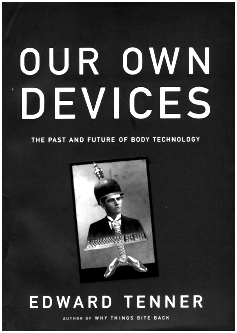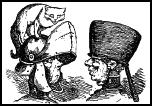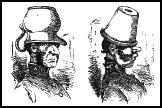Own
Devices
The Past and Future
Of Body Technology
Edward Tenner
(Knopf)
 There is an unseen epidemic in the industrial world: the rate of myopia --- nearsightedness. It runs to 20% in those older than sixty-five, but 60% in those between twenty-three and thirty-four. The reason? Schoolwork. "Among children enrolled in U. S. Orthodox Jewish secondary schools, males studied sixteen hours each school day ... and had an 81.3 percent myopia rate ... Asian societies with rigorous school programs are similarly affected. In Hong Kong 75 percent of high school students and 90 percent of college students are now myopic."
There is an unseen epidemic in the industrial world: the rate of myopia --- nearsightedness. It runs to 20% in those older than sixty-five, but 60% in those between twenty-three and thirty-four. The reason? Schoolwork. "Among children enrolled in U. S. Orthodox Jewish secondary schools, males studied sixteen hours each school day ... and had an 81.3 percent myopia rate ... Asian societies with rigorous school programs are similarly affected. In Hong Kong 75 percent of high school students and 90 percent of college students are now myopic."
- One of the great (and profitable) inventions of the 19th century was the "metallic pen" with a split nib. One factory in England was sending out "32,000 gross each week." The invention inspired classes in penmanship, created different scripts in different countries --- France had a cursive script that "is still visible on some restaurant menus," and even poetry:
Give me a pen of steel!
Away with the gray goose quill!
I will grave the thoughts I feel
Withe a fiery heart and will ... -
 "Paradoxically," says Tenner, the helmet is "one of the oldest external modifications of the body, possibly older than the chair." The first helmets appeared in the 3rd century, B.C., made of leather, felt, and boars' tusks. The main task of a modern helmet like the earlier ones is protection, but it must be of such a nature so as to not cause undue discomfort, else the user will abandon it. During World War II, GIs found their helmets not only worked for protection but as "a seat, pillow, washbasin, cooking pot, nutcracker, tent-peg pounder, wheel chock and ... popcorn popper." Current helmets are made of Kevlar, used not only by soldiers, but by construction workers, football and baseball players, police and --- increasingly --- by demonstrators.
"Paradoxically," says Tenner, the helmet is "one of the oldest external modifications of the body, possibly older than the chair." The first helmets appeared in the 3rd century, B.C., made of leather, felt, and boars' tusks. The main task of a modern helmet like the earlier ones is protection, but it must be of such a nature so as to not cause undue discomfort, else the user will abandon it. During World War II, GIs found their helmets not only worked for protection but as "a seat, pillow, washbasin, cooking pot, nutcracker, tent-peg pounder, wheel chock and ... popcorn popper." Current helmets are made of Kevlar, used not only by soldiers, but by construction workers, football and baseball players, police and --- increasingly --- by demonstrators.
- Flip-flops --- zori sandals --- are produced at a rate of 125,000,000 a year. Calvin Klein has a pair for $245. But it is the cheapest and most comfortable footware for millions of people over the world. Regular thong sandals cost 30 - 40 cents to manufacture. Havaianas has sold over two billion pairs of its brand flip-flops. But "discarded plastic footware is a major component of the world's flotsam, washing up in surprising places. In 1996 the Australian Cocos and Keeling Islands, home to a number of endangered species, were assaulted by hundreds of thousands of discarded flip-flop sandals, rejects of Indonesian manufacturers ... One Australian member of Parliament said, The beaches are the home of the green sea turtle and the blue rubber thong. One of them has to go. And the surfer Allan Seymour said, We call them go-aheads, because you can't walk backwards in them."
-
 NASA determined that the most natural angle between upper body and thighs is 135-degrees, but a century before, Nature magazine found that "the bamboo veranda chair of colonial India, with its W-shaped profile" was the most optimal seating. Architects consider the Persona, a body-conforming chair built by Mario Bellini to be "a style leader in its category." Gordon Hewes, the anthropologist found that the most comfortable static position is "the Indian technique of squatting on [one's] heels. "By varying it --- changing foot positions and resting his chin, his armpits, or his elbows on his knees --- he discovered that he could stay in one spot for hours while relaxing every muscle ... Of human postures," says the author, "this deep squat may be as widely distributed as chair sitting, being used by about a quarter of humanity when Hewes wrote."
NASA determined that the most natural angle between upper body and thighs is 135-degrees, but a century before, Nature magazine found that "the bamboo veranda chair of colonial India, with its W-shaped profile" was the most optimal seating. Architects consider the Persona, a body-conforming chair built by Mario Bellini to be "a style leader in its category." Gordon Hewes, the anthropologist found that the most comfortable static position is "the Indian technique of squatting on [one's] heels. "By varying it --- changing foot positions and resting his chin, his armpits, or his elbows on his knees --- he discovered that he could stay in one spot for hours while relaxing every muscle ... Of human postures," says the author, "this deep squat may be as widely distributed as chair sitting, being used by about a quarter of humanity when Hewes wrote."
In the winter of 1999 I wrote a review of James C. Scott's Seeing Like a State. "I've been trying to write about this son-of-a-bitch for six months now," I confessed, and continued: "I guess I'll just never do it. The reason: Seeing Like a State is an astonishing, brilliant, exquisitely written, sound, wise, and (sometimes) funny --- and (almost always) a sad tale of how governments screw up."
I went on,
I've been reviewing books for over forty years, and can only think of a handful that reach the stature of this one. The closest is Marshall McLuhan's Understanding Media which turned our view of media on its head (he included cars and timekeepers as "media," just to thicken the plot.)
I picked up McLuhan's book back in 1963 at the University Bookstore. I flipped through it, put it back in the shelf, drove home, had a beer, then got back in the car, drove twenty miles back to the bookstore, and bought it. I ended up using it as required reading in all my media classes.
a sense of fun, and articulate good sense. Scott can look at German forestry practices during the 17th and 18th centuries, and tie them together with government use of census (to get a handle on potentially taxable subjects) along with the history of grid layout of land (an easy source for interchangeable information for ownership and tax records, plus the easy divisibility of the land for speculative purposes).
I have now run into the same problem with Our Own Devices. It is, on its own, so elegant that to write about it feels not quite right. I am reminded of Diderot's statement about coming up with a perfect map of the world. He wrote, "It would have to be the world." How can we write about such seminal works as this one (and Understanding Media and Seeing Like a State) except to tell others to take it whole. The best I can do is to give a few choice samples, as I did above; explain that this is one you want to mull over for weeks if not months, as I did. Pick it up, and join the author in investigating the world of simple things, and in the process find out how complex they are: desks or chairs or shoes or keyboards or helmets or glasses: The pince-nez, kept in place by spring pressure alone, was the first eyewear to become a fad among both men and women. Many opthalmologists and opticians considered it difficult to fit, and the glasses fell off repeatedly. Yet ... contemporaries thought the design avoided the "elderly appearance" of spectacles with temples. Tenner is genius, pure and simple, his writing is a pleasure, and Our Own Devices is the fascinating world around you brought to life in a thousand thousand details. Get it. Got it? Good. Seeing Like A State (I concluded) is that kind of a go-
Seeing Like A State (I concluded) is that kind of a go-